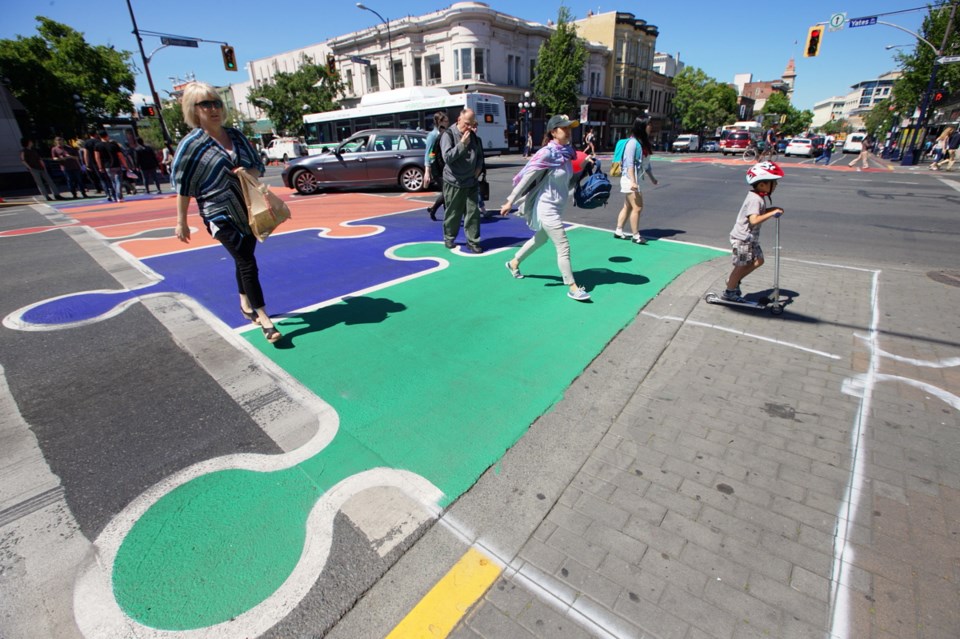Depending on who you talk to, the painted puzzle crosswalks and sidewalks that materialized on Douglas Street this spring either add a funky, cool shot of colour to downtown’s main drag or are the worst use of city money in 35 years.
That’s OK, says Fran Hobbis, who managed the Douglas Street Pilot Improvement Project dubbed stArt on Douglas, because one of the project goals was to simply create a conversation.
“We were OK if people didn’t like it. It would be great if they loved it, but the idea was to get people talking about something that we could do,” Hobbis, past chairwoman of the Downtown Victoria Business Association, told Victoria city councillors during a recent project update.
The $180,000 initiative included crosswalks painted with puzzle pieces at Douglas and Yates streets, colourful ribbons of art added to a building at 1280 Douglas St., a new bike rack on the northwest corner of the intersection and a retail kiosk for pop-up commerce on the southeast corner.
It was funded equally by the Downtown Victoria Business Association, Downtown Victoria 2020 and the City of Victoria.
To say reaction to the initiative has been mixed would be an understatement, Hobbis said.
Social media commentary saw lots of “likes” and “loves” without any commentary and lots of negative commentary. She called the reaction “pretty typical.”
“People really have to love something before they say something about it, but they only have to dislike it a tiny bit before they say something,” Hobbis said.
“My favourite bouquet was: ‘Art is good … Crosswalks are good. It’s all good.’ My favourite beef: ‘Biggest waste of money I’ve ever seen in 35 years of living in Victoria.’ ”
Overall, she said, it’s difficult to evaluate the return on investment for public art.
Not all of council was particularly impressed.
“When I look at value for money, I’m not sure we got it,” Coun. Ben Isitt said. “There’s paint on the roads. There’s paint or stickers on a building. There’s a very nice bike shelter and I think that’s an amazing amenity.
“But just thinking of other projects of a similar nature that the city undertakes, I’m not sure how this project crept up toward the budget that was approved.”
Coun. Jeremy Loveday, council’s liaison to the city’s accessibility working group, said he loves the idea of surprise enhancements in the downtown.
But he said he heard concerns from several people with vision impairments: “This project impeded their ability to tell where the road was going to start because of the crosswalk pieces, the puzzle pieces.”
The city should be the final arbiter of what is painted on streets and see the design before it’s implemented, he said. “I think we can’t have surprises in our roadways that aren’t tested.”
The pilot project, which came in on schedule and on budget, had its genesis in the Arriving at Douglas visioning document created for the DVBA through a design charette last year.
That 20-year plan envisions Douglas Street between Hillside Avenue and Belleville Street transformed into a place where pedestrians, cyclists and public transit eventually take priority over cars.



